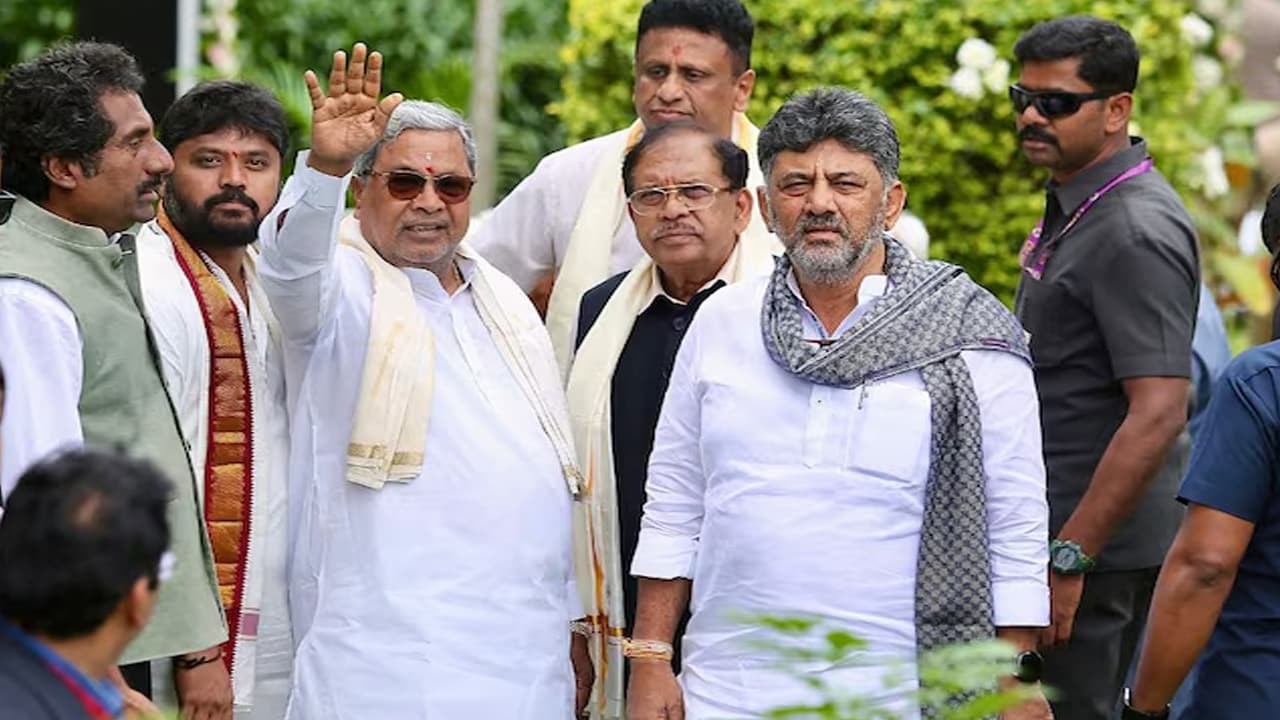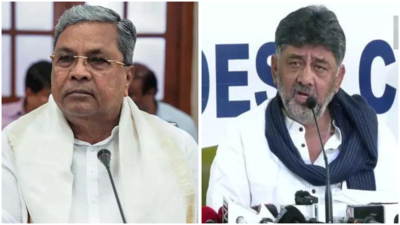The simmering tensions between Karnataka’s Deputy Chief Minister DK Shivakumar and Chief Minister Siddaramaiah have erupted into a full-blown political storm, gripping the state’s Congress leadership. The rivalry, long whispered about in political corridors, has now spilled into public view with subtle jibes, strategic moves, and factional maneuvering. Party insiders reveal that the tussle for dominance is not only about political ideology but also about control over key portfolios, influence on party decisions, and the long-term goal of securing the Chief Minister’s seat. Both leaders command significant loyalty within the party, making this a high-stakes battle.
Observers note that this rivalry has historical roots, dating back to earlier party structures when both leaders were vying for influence over the Karnataka Pradesh Congress Committee. While Siddaramaiah’s mass appeal comes from his grassroots connect and championing of social justice policies, Shivakumar’s strength lies in his aggressive organizational skills and ability to mobilize resources. This combination of contrasting styles and ambitions has created an ongoing power equation that is hard to balance. Party high command in Delhi is reportedly keeping a close watch, wary of the fallout such a conflict could have in the run-up to the next elections.
The public perception of this power tussle has been shaped by recent incidents where both leaders were seen pushing their own agendas, sometimes at the cost of collective cabinet cohesion. While official statements stress unity, behind the scenes, meetings and decisions often reveal a competitive undertone. Political analysts warn that if the Congress leadership does not address this internal friction, it could lead to factional divisions that might be exploited by opposition parties. The coming months will be crucial in determining whether the two leaders can reconcile their ambitions or if Karnataka will see deeper cracks within the ruling dispensation.

Historical Rivalry and Party Equations
The relationship between DK Shivakumar and Siddaramaiah has never been one of unshakable trust, despite occasional displays of camaraderie. Political history shows that both have maneuvered independently to consolidate their positions in Karnataka politics, often seeking to sideline each other’s influence. During Siddaramaiah’s earlier tenure as Chief Minister, Shivakumar was considered an emerging power center, using his political network and fundraising capabilities to gain favor with the party leadership. This dynamic created an undercurrent of competition that has persisted into the present administration.
Party veterans suggest that the current government’s stability hinges on how these two leaders manage their rivalry. With each enjoying strong support from different caste bases—Siddaramaiah from the AHINDA (Backward Classes, Dalits, and Minorities) coalition and Shivakumar from the Vokkaliga community—the Congress cannot afford an open split. However, subtle power moves, such as controlling key cabinet committees or influencing bureaucratic appointments, have intensified the cold war between the two. The challenge for the Congress high command is to strike a balance that prevents either leader from feeling sidelined, while also ensuring governance does not suffer in the process.
The deepening rivalry between DK Shivakumar and Siddaramaiah is beginning to cast a long shadow over Karnataka’s Congress government. Insiders say the tension has reached a point where even routine cabinet meetings have become arenas of subtle one-upmanship. Decisions are often delayed as ministers gauge which faction a proposal aligns with before lending their support. This slow-burning feud has not only affected the morale of the party rank and file but also given the opposition ample opportunity to paint the Congress as divided and distracted from governance. For the public, the growing sense is that leadership battles are overshadowing real issues.

Siddaramaiah, known for his firm grip on policy matters, has reportedly been cautious in sharing decision-making space with Shivakumar. Sources suggest that while Siddaramaiah relies heavily on his trusted bureaucrats, Shivakumar prefers building influence through direct outreach and strategic alliances with local leaders. This difference in approach has led to frequent overlaps in roles and responsibilities, frustrating both camps. Party loyalists warn that without a clear demarcation of authority, the state government risks sending mixed signals to voters, especially in regions where Congress needs to consolidate support ahead of key by-elections.
Shivakumar’s growing clout as Karnataka Pradesh Congress Committee President has made him a formidable political figure in his own right. His skill in mobilizing funds and resources for election campaigns has strengthened his influence within the national leadership. However, this very strength has also intensified Siddaramaiah’s concerns about Shivakumar’s ambitions. The Deputy Chief Minister’s proactive engagement with community leaders, industrialists, and grassroots workers has led many to see him as a natural successor to the top job—something Siddaramaiah’s camp is said to be resisting fiercely.
The Congress high command’s attempts to keep both leaders satisfied have so far been limited to symbolic gestures, such as allowing them equal public visibility during events and rallies. However, these measures have done little to resolve the underlying friction. In fact, political observers note that such an arrangement may be fuelling the rivalry further, as each leader tries to outshine the other in public appearances. With each passing month, the uneasy truce appears more fragile, and questions about leadership transition grow louder within party circles.
On the ground, the power struggle is already influencing local politics. District-level leaders often find themselves having to pick sides, leading to factional divisions in party committees. This polarization has, in some cases, resulted in stalled development projects and infighting over resource allocation. Grassroots workers worry that prolonged factionalism will erode public trust, as voters increasingly view the Congress as preoccupied with internal battles rather than addressing pressing governance challenges like unemployment, infrastructure, and rural distress.
Meanwhile, the opposition—particularly the BJP—is closely monitoring these developments, preparing to exploit any visible cracks in the Congress leadership. BJP strategists are said to be working on campaigns highlighting the Congress’s “two power centres” narrative, portraying it as a sign of instability. In the charged political climate of Karnataka, such narratives can be potent, especially when coupled with targeted messaging in regions where Congress margins of victory are slim. The Janata Dal (Secular), too, is exploring ways to capitalize on the Congress’s internal discord.
Impact on Governance and Future Outlook
The ongoing power struggle is not just a matter of internal party politics; it has implications for governance and policy implementation in Karnataka. Cabinet decisions, budget allocations, and development project approvals are reportedly becoming battlegrounds for influence. Ministers aligned with either leader often lobby aggressively for their respective agendas, slowing down the decision-making process. If this competitive dynamic continues unchecked, it could lead to policy paralysis in key sectors such as infrastructure, education, and social welfare.
Analysts predict that the resolution—or escalation—of this rivalry will shape Karnataka’s political landscape in the years to come. If managed well, it could result in a balanced power-sharing arrangement that harnesses both leaders’ strengths. If not, it could spiral into an open confrontation, weakening the Congress’s chances in upcoming elections. For now, all eyes are on the high command’s next move, as Karnataka’s political drama continues to unfold with intensity and unpredictability.

The high command’s dilemma lies in the fact that both Siddaramaiah and Shivakumar are indispensable to the party’s electoral success in Karnataka. Removing or sidelining either could alienate a large voter base. Yet, allowing the rivalry to fester could weaken the party’s ability to present a united front in 2026. A possible middle path, some suggest, could involve grooming a third leader to act as a bridge between the two camps—though whether either heavyweight would allow such a figure to emerge remains doubtful.
Observers say that the coming state budget session will be a litmus test for the government’s unity. If both leaders manage to present a cohesive fiscal plan and share credit for policy initiatives, it could temporarily ease tensions. However, if disagreements spill over into the public domain, it will confirm suspicions that the rift is widening. Political insiders also believe that upcoming panchayat elections will serve as a battleground for factional dominance, with each camp fielding loyal candidates in key constituencies.
The media’s role in amplifying this feud cannot be ignored. Every small disagreement between the two leaders tends to become headline news, further fuelling speculation about their political futures. While both Siddaramaiah and Shivakumar have repeatedly denied any rift, their body language and strategic decisions often tell a different story. In an age of instant news and social media, even a momentary display of tension can quickly turn into a viral narrative, making damage control a constant challenge for the party’s communication team.
Ultimately, the Shivakumar-Siddaramaiah rivalry reflects a broader struggle within the Congress to balance ambition and unity in a state where political fortunes can shift rapidly. If the leadership fails to manage this dynamic effectively, it risks losing the momentum it gained in the last assembly elections. For now, Karnataka remains a stage where two of the party’s most formidable leaders are engaged in a complex dance of cooperation and competition—a performance that could determine not just their own careers, but the future of the Congress in the state.
Follow: Karnataka Government
Also read: Home | Channel 6 Network – Latest News, Breaking Updates: Politics, Business, Tech & More

